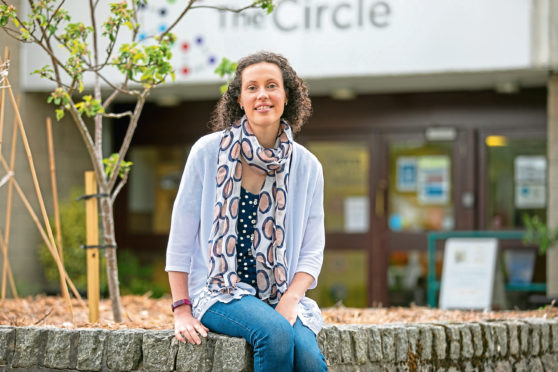
After months of virtual meetings, birthday parties and family quizzes, logging into Zoom has, for many, become something of a chore – but not for Jennifer Gall.
The 33-year-old, from Dundee, has found a new community of like-minded friends online during the pandemic, having volunteered to help establish and host virtual cafe catch-ups for young people affected by stroke. Every second Friday, the growing group of survivors, carers, family and friends come together to share stories, swap tips and provide general support, which Jennifer admits has become the highlight of her week.
She describes the Young Persons’ Stroke Cafe, as it’s known, as an invaluable and important service – and one she would have found extremely beneficial when she herself suffered a stroke aged just 18.
“I was so excited about going to Abertay University to study Business Studies, but one day in February 2007, everything changed,” explained Jennifer, who began volunteering for Stroke Association Scotland several years ago.
“It was lunchtime. I went to the toilet, came out, and I don’t remember anything after that. I woke up in hospital a few hours later and didn’t know what was happening. I couldn’t speak or move. It was just a life-changing event.”
A stroke happens when the blood supply to part of the brain is cut off, killing brain cells and potentially causing serious, long-term damage.
The effects of a stroke depend on where it takes place in the brain, but can include physical impairment, communication difficulties, and memory problems. Though more common in older people – due to the fact our arteries become harder and narrower and therefore more likely to become blocked with age – anyone can have a stroke.
For Jennifer, the road to recovery was long, having lost her speech completely, as well as the movement in her right arm and leg being badly affected.
She explained: “It was a long process. I thought it would be fixed within a year but I was totally wrong. It has taken me 10 years to realise this is who I am now, and no one can change the past to make it rosier in the future.
“At the time, I was totally reliant on my parents for everything, and it took years to regain my confidence. I still face challenges – my right hand is still affected and it’s sometimes hard talking to strangers – but I’m really happy now and just getting on with life.
“I don’t like to dwell on what happened, so I just take every opportunity that comes to me. It gives you a different perspective on life.”
With in-person events and groups unable to take place during the pandemic, the Stroke Association quickly established the Here For You telephone service and online Stroke Cafes, both of which are run by dedicated volunteers, and recently received £198,000 of funding from The National Lottery Community Fund.
John Watson, associate director of Stroke Association Scotland, says the services have been a lifeline for many, particularly younger people.
He said: “We often hear from people that they feel like they’re on their own – there’s nobody else in the same situation, and while there are other stroke survivors, their conditions and situations will be very different.
“The reason for having very specific Stroke Cafes, aimed at young people, is to try and tackle that sense of isolation and give a bit more emotional and practical support. That sense of solidarity and being ‘in this together’ has an enormous benefit, and sits alongside clinical support such as physiotherapy and speech therapy.
“The prohibition on meeting up in person has been particularly impactful for young stroke survivors. We’ve heard from a lot of people just how isolated they felt over the last year and a bit, so the shift we have made to setting up these online places where people can meet has been an absolutely necessary part of our response.”
Having been helped by the Stroke Association during her rehabilitation, Jennifer always knew she wanted to give back to the people and organisation who provided so much help during such a difficult time.
She continued: “I was the youngest person on the stroke ward, and the youngest person at the rehabilitation centre, too, when I transferred three weeks later. When a younger person has a stroke, it’s a totally different experience.
“I felt honoured to be asked if I would help to get the Young Persons’ Cafe off the ground. The general Stroke Cafe is often older people, and we realised we needed to have a space for younger people to connect with other stroke survivors who are the same age and going through the same thing. The Cafe grows every time and it’s going super well so far.
“For me, it’s about not looking back or focusing on the bad things. You need to look forward and take every opportunity that’s given to you because you just know what is around the corner.”
Visit stroke.org.uk to find out more.

Enjoy the convenience of having The Sunday Post delivered as a digital ePaper straight to your smartphone, tablet or computer.
Subscribe for only £5.49 a month and enjoy all the benefits of the printed paper as a digital replica.
Subscribe